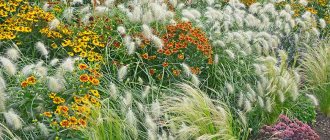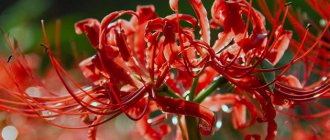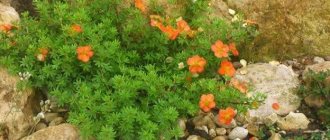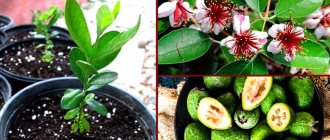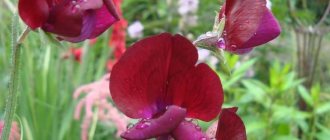This flower came to us from America. Garden varieties are called Helenium hybridum. This is a beautiful, long-flowering perennial plant, the decorative qualities of which are not sufficiently appreciated, although the flower certainly deserves attention. Its charming, brightly colored flowers will be the pride of every flower bed. Flowers look especially beautiful in gardens decorated in a romantic, naturalistic or rustic style.
In this article we will tell you everything about the perennial helenium flower - planting and care, photos of varieties, features and conditions of cultivation and propagation.
Description of the species
Hybrid helenium perennial is one of the most common species of the genus helenium from the family Asteraceae. The plant forms a large, strong bush, with spreading shoots.
Table. Main characteristics of Helenium
| Characteristic | Description |
| Height, shape | The plant grows to a height of 1.5-2 meters, has thin, highly branched shoots, and a lush shape. |
| Leaves | Green, lanceolate, glandular, spotted, jagged. The foliage dries out when the plant begins to bloom and may have a lot of dry leaves, but this is not a problem - due to the height of the bush, helenium is usually planted at the back of the flowerbeds. |
| Height | Plant growth is rapid, shoots often bend and fall to the ground, requiring support. |
| Trimming | To delay flowering for about 2 weeks, part of the plant’s stems is cut off in May-June, and the cut shoots are used for propagation. |
| Bloom | The flowering period of helenium is long (June-October). The first flowers appear at the ends of the shoots in June and develop continuously until late autumn (the end of flowering is October). At the top of each shoot, a single flower appears with a strongly protruding, almost circular flower head and small, slightly curled petals, giving the appearance of a small, colorful fan. |
| Inflorescence | Flower baskets are 3-5 cm in diameter, the edges are yellow, yellow-brown or brown-red, there are 3 separate teeth at the end of the petal. The tubular flowers, yellow or brown, are compact and form a dome-like inflorescence inside the inflorescence. There are varieties and varieties with yellow, red, brown, and orange stripes. The color, height, and size of flowers depend greatly on the variety. |
Be careful! Plant heleniums away from small children, the plant causes skin allergies and poisoning.
general information
Helenium is a classic representative of the Asteraceae. In nature, it lives in different regions of America, and especially the USA. According to legend, the spectacular flower received its name in honor of the beautiful Helen, the one who was the cause of the Trojan War.
The beauty of helenium is only emphasized by the fact that it blooms late, when almost everyone has already finished blooming. So if you need the perfect fall option, here it is, at your disposal!
A dense bush of helenium is individual plants that simply grow in groups. The height of the peduncles reaches 1.5 m, and the buds are single or in corymbose inflorescences. It is interesting that in the fall the root system of helenium dies, but the underground buds form new roots and a rosette.
Photo: 2sotki.ru
Varieties
There are many attractive garden varieties of Helenium. Below is a small grouping of varieties by:
- color of flowers;
- bush height;
- flowering period.
Bright yellow
- Canaria (Canaria) - a variety with yellow, double outer petals and a yellow center, 1.5-1.7 meters high;
- Double Trouble - a variety with yellow outer petals and a yellow, yellow-green center, height 1.7 meters;
- Goldrausch - with yellow petals and a brown-yellow basket, height 1.5 meters;
- Bishop - with yellow petals and yellow-brown baskets, bush height 90 cm.
Orange or red-brown
- Moerheim Beauty - flowers with orange-red petals and a brown-red basket, helenium height - 0.8 meters;
- Rubinkuppel - almost red petals and a yellow-brown, not very protruding small basket, height 1 meter;
- Rubinzwerg - helenium suitable for cut flowers, for planting in groups, red flower with a yellow center, flowering time - July-September. Green leaf, bush height 50 cm, requires high humidity, sunny position, permeable, fertile soil.
Two-color
- Fursiegel (Feuersiegel) – yellow-red petals and a brown basket, helenium height 90-120 cm, with multi-colored flowers;
- Flammenrad - variety with yellow-orange petals, height 1 meter;
- Rauchtopas - with yellow petals in the upper part, orange, brown baskets in the lower part, height - 1 meter.
Low and compact varieties
- Moerheim Beauty – red petals, brown center, 80 cm high;
- Crimson Beauty - orange-red variety, 60 cm high;
- Golden Jugend – yellow helenium 80 cm high;
- Red Army - with red petals and brown baskets, perennial helenium height 60 cm.
The earliest - blooming from June to mid-August
- Moerheim Beauty - with copper-red, lens-shaped, tubular-brown flowers, plant height 70-120 cm;
- Pumilum Magnificum (Pumilum Magnificum) - helenium with golden-yellow, lichen, tubular flowers - yellow, reaches a height of 60-80 cm;
- Waltraut is a perennial variety with orange-yellow, lens-shaped, tubular-brown flowers, reaching a height of 80-100 cm;
- Wesergold - with yellow, bunched, tubular-brown flowers, shoot height 55-115 cm.
Medium flowering period (late July-August)
- Helenium autumn (Autumn Lollipop) - perennial yellow-leaved variety with yellow-brown tube flowers, helenium height 60-90 cm, blooms until September;
- Biedermeier - red flowers with a yellow frame, tubular-brown, the plant reaches a height of 100-165 cm, blooms until the end of August;
- Goldrausch - perennial variety with golden-yellow reed, tubular dark brown flowers, plant height 140-150 cm, bloom until the end of August;
- Helena group - offered in yellow and red-brown tones, plant height 50-120 cm, bloom in the first year when propagated from seeds, inflorescences adorn the plants until October;
- Mariachi group Mariachi is a perennial characterized by a dense bush, blooms from July to September, available in four varieties: Fuego, Siesta, Salsa, Sombrero.
Late flowering varieties – August-September
- Bandera - red flowers with a yellow frame, tubular yellow-brown, plants grow up to 40-50 cm, bloom until September;
- Baudirektor Linne - perennial variety with red, lens-shaped, tubular-brown flowers, plant height 100-120 cm, flowering until early September;
- Wildform - with yellow inflorescences, grows to a height of 80-150 cm, blooms until October.
Growing and care
Helenium flowers are beautiful, extremely decorative and easy to grow. The plant is perennial, frost-resistant, tolerates planting well in open ground, and is easy to care for.
Soil requirements, positions
The requirements for growing helenium are as follows:
- position – they grow better and bloom more beautifully in sunny or slightly shaded positions;
- soils – fertile, humus-rich, permeable, moderately moist substrates are required;
- frost resistance - plants are quite resistant to low temperatures and do not require winter shelter, but some varieties need to be protected for the winter.
Attention! Helenium does not develop well on impermeable clay, poor sandy soils, or soil that is flooded in winter.
Diseases and pests
The perennial helenium is highly resistant to diseases and practically insensitive to pests.
Helenium diseases:
- The main problem is viral diseases that interfere with growth and distort leaves and flowers.
- Another problem is gray mold, which causes damage to leaves and death of flowers. Infected shoots should be immediately removed and burned.
Attention! Do not throw damaged parts of the plant into compost.
Caring for helenium includes systematic inspection of the plant and pest control. When it comes to pests, the main enemy of helenium, especially young shoots, leaves and flower buds, is snails. Natural enemies of snails:
- frogs,
- hedgehogs,
- lizards,
- shrews,
- birds,
- ground beetles.
Therefore, we need to try to increase their population. A small pond is made for frogs in a quiet place. Hedgehogs build a shelter from branches. The beetles that are useful in this fight will hide in the bark mulch. It is better not to use toxic chemicals in the garden that also poison beneficial animals.
Snails do not like some plants, for example:
- sagebrush,
- chamomile,
- sage,
- yarrow.
By planting them in beds near heleniums, we protect valuable plants.
Fertilizer
The perennial helenium flower is quite voracious and requires systematic fertilization. It blooms better in fertilized soil. It responds well to fertilizing with natural fertilizers (compost). Apply an appropriate dose of artificial compounds - preferably a mixture intended for flowering plants.
Helenium care
It is easy to care for a flower; agricultural technology includes the following activities:
- Removing inflorescences. It is necessary to promptly remove faded inflorescences, stimulating the plant to produce subsequent flowers.
- Watering. Supplemental irrigation is required during periods of drought.
- Removing weeds. Plants grow quickly, so they usually do not require weeding. It is necessary to systematically care for the flowerbed and remove weeds after sowing, while the flower is small.
- Garter. Tall varieties need support during the flowering period; under the weight of flowers, helenium stems often bend excessively.
Where to plant - in the sun or in the shade, soil requirements
Helenium is a sunny flower. It does well in direct sunlight. Can be planted in partial shade. But in constantly shaded areas the plant grows poorly, produces fewer flowers, and has a less beautiful appearance.
Pay attention to the condition of the soil for planting. Soil with neutral acidity is suitable for helenium. If you have a low area, first arrange drainage in the flowerbed. The root system quickly rots when water stagnates.
Heleniums grow well in loose, breathable soil. If the soil is clayey, be sure to add sand. After watering, always loosen the soil a little.
Reproduction and planting
Often gardeners try to propagate flowers on their own. It is not difficult.
Helenium reproduces in 3 ways:
- dividing the bush;
- cuttings;
- seeds.
Dividing the bush
The best way to propagate helenium is to divide the bush. The procedure is usually carried out in the spring (March-April), once every 2-3 years. Dividing the bush is very beneficial for the health of helenium. In the spring, a plant with a lump of earth is dug up, the youngest, outer parts are separated, used for planting, the middle is thrown away. Young plants will be more viable and will provide more new flowers.
Propagation by cuttings
A more complex way to obtain young plants is by planting cuttings. Cuttings are prepared in the spring in April-May, cutting off the upper part of the shoot. The shoots are germinated and rooted in a moist sandy-peat substrate. The seedlings take root within a week.
Propagation by seeds
Helenium produces a large number of seeds. It should be borne in mind that varieties propagated from seed usually do not retain the characteristics of the mother plant.
Plant seeds in pots or containers from February to June. 1 g contains 2400-5000 seeds (depending on the variety); to obtain 1000 plants, 0.5 g of seeds should be sown. It is preferable to sow seeds in trays. After sowing, cover the seeds well with a small amount of vermiculite to ensure sufficient moisture.
The substrate temperature during the germination period should be 18-22 ° C. Germination lasts 2-3 weeks. After the formation of the first true leaves, the temperature should be gradually lowered to 12-15 ° C, and the humidity around the plants should be reduced.
How and when to plant helenium?
Seedlings should not be prepared and planted in the fall, because young plants will not survive winter, especially if the weather at this time of year is constantly changing (alternating rain and frost). Heleniums transplanted in autumn may rot in winter.
Seedlings should be planted in open ground in the spring, at the end of May. Planting pattern: at a distance of 50 × 50 cm. When growing, a uniform planting is obtained.
For planting helenium, it is recommended to use a peat substrate with a low clay content (15-30%) and a loosening material, such as sand (0-20%), with a soil pH of 5.6-6.4.
Planting helenium can be done in the following ways:
- separately in pots with a diameter of 11-12 cm;
- 2-3 jokes in pots with a diameter of 15 cm.
When planting, it is preferable to strengthen the substrate with a slow-acting multicomponent fertilizer at a dose of 1.5-3.0 kg/m³.
Care after landing
It is recommended to feed young seedlings after the appearance of true leaves and after planting in pots with multicomponent fertilizers. If the soil is too wet and the temperature is low, the plants may die.
Helenium – photo
Bright and colorful helenium plantings immediately attract all eyes. They look especially impressive against the backdrop of green foliage!
Photo: u-florista.ru
Photo: fedsp.com
Photo: 2sotki.ru
Photo: 123ru.net
Photo: cveti-rasteniya.ru
Photo: sady-msk.ru
Photo: cveti-rasteniya.ru
Photo: cveti-rasteniya.ru
Photo: fotokto.ru
Photo: jpuzz.ru
Photo: u-florista.ru
Photo: disota.ru
Photo: 6cotok.org
Photo: dachanaladoni.ru
Photo: nadachedom.ru
Photo: mir-ogorodnikov.ru
Photo: lanshaft.com
Photo: promessedefleurs.com
Photo: botanichka.ru
Photo: alexsad.ru
Photo: shop.yunsxxi.ru
Photo: 2sotki.ru
Photo: vsezdorovo.com
Photo: packagile.ru
Photo: kakprosto.ru
Did you like the post? Subscribe to our channel in Yandex.Zen, it really helps us in our development!
Application in landscape design
Bright autumn helenium will decorate every flowerbed. The flowers are called "hot" because they bloom in fall colors: orange, rust, red, yellow and shades thereof. Peduncles reach a considerable height, much higher than a meter, due to which they dominate in compositions. However, they need to be supported and tied up. Looks beautiful in combination with other naturalistic tall summer flowering perennials:
- rudbeckias,
- asters,
- yarrow,
- chrysanthemums,
- bouquet hydrangea,
- larkspur.
Bright, tall bushes work great against a white wall or openwork fence. Because of the tendency to bare the lower parts of the shoots, especially in drought, it is advisable to plant them in the company of other, shorter plants that cover the unattractive bare shoots. Garden heleniums are excellent plants for cut flowers.
Choosing the right plants in your neighborhood will ensure that you compensate for the flowering from July to October, when many perennials disappear. This is worth taking into account when planning next year's plantings, because heleniums return to gardens very often.
The flowers look beautiful in English, naturalistic or country style gardens, but can be used successfully in other garden styles.
Depending on the height of the bush, the planting method changes:
- Tall varieties of helenium are ideal for flower beds on the top floor and go well with asters, rudbeckias, and phlox. You can create interesting, multi-group decorative combinations along walls and fences.
- Low varieties can be planted at the beginning of the ridges, arranging plants with catnip, daylilies, yarrow, ornamental grasses, salvia, low asters.
Heleniums bloom in fall colors: orange, red, yellow and shades thereof. They are a beautiful and stunning garden perennial with dazzling petals and bulbous baskets, most of which include many garden giants. They are not only tall, but also very stable. The peak of flowering is observed in the summer in July-August; the flower continues to remain attractive until late autumn. They have many advantages because they tolerate adverse growing conditions and reward gardeners with beautiful flowers for a long time. Helenium is loved not only by gardeners, but also by pollinating insects.
After flowering
Collecting seeds
The seeds must be collected before the rainy season begins in the fall, otherwise they will simply rot. The maturity of the seeds can be determined by the tubular flowers that have become black and the reed flowers that have darkened. However, you need to remember that it is recommended to purchase seeds in specialized stores. The same seeds that you collected have extremely low germination, and they may not retain the varietal characteristics of the mother plant.
Wintering
For wintering, you need to cut the shoots almost to the surface of the ground, so only cuttings with a height of 10 to 15 centimeters should rise above the soil. Then the surface of the area is sprinkled with a layer of mulch (sawdust or moss), and lutrasil is spread on top of it in order to protect helenium from severe or light winters.
GELENIUM: Transplantation and division
